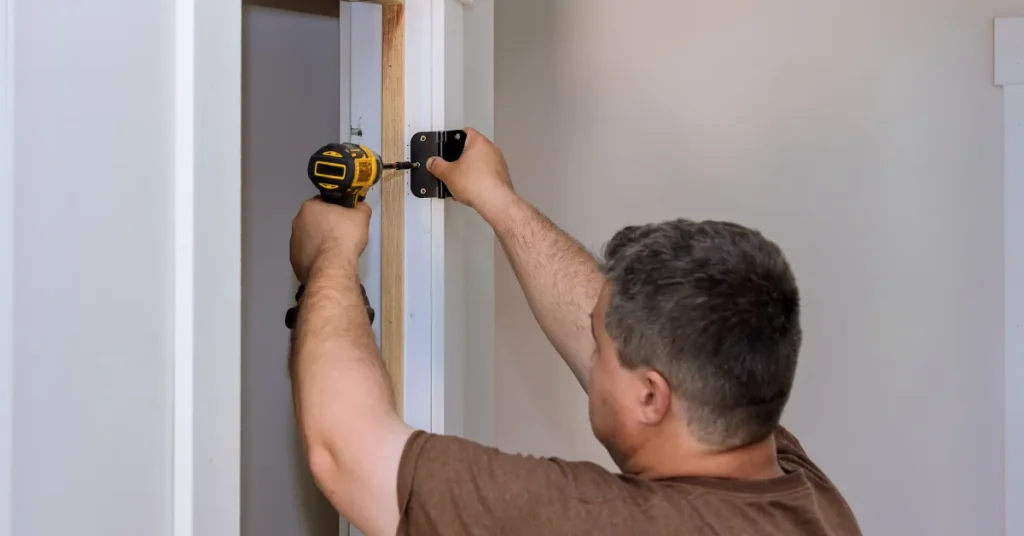A standard door frame is about 0.75 to 1 inch thick. The thickness can vary depending on the door’s design and material.
Understanding the dimensions of door frames is crucial for both construction professionals and homeowners aiming to ensure proper door installation and maintenance.
Door frames serve as the backbone of door installations, providing structural support and shaping the aesthetic appeal of an entryway.
While their thickness generally ranges between three-quarters of an inch to an inch, this can differ based on the type of door, whether it’s interior or exterior, and the requirements of the building design.
Key considerations when evaluating the thickness of a door frame include the compatibility with the door slab, the intended use, and the architectural style of the building.
Keeping these factors in mind helps in selecting the correct door frame, which contributes to both the functionality and the overall visual harmony of a space.

Standard Door Frame Dimensions
Understanding the Standard Door Frame Dimensions is crucial for homeowners, builders, and DIY enthusiasts. Door frames not only support the door, but they also impact the appearance and functionality of a doorway.
Whether replacing or installing a new door, knowing the common measurements ensures a smooth process. Let’s delve into the typical sizes for interior and exterior door frames.
Common Interior Door Frame Sizes
Interior doors usually have a standard thickness that range from 4 9/16 inches to 7 1/8 inches. This account for wall thickness and sheetrock. The most frequent width for interior door frames is about 30 inches.
But, this can vary to fit door sizes that range from 24 inches to 36 inches. Interior door height generally stays consistent at around 80 inches.
| Door Width (Inches) | Standard Frame Width (Inches) |
| 24″ | 26″ |
| 28″ | 30″ |
| 30″ | 32″ |
| 32″ | 34″ |
| 36″ | 38″ |
Typical Exterior Door Frame Measurements
Exterior door frames are built to be more robust as they serve as a main point of entry. The standard thickness falls between 4 9/16 inches and 7 1/8 inches to accommodate different types of exterior walls and insulation.
Widths normally start at 36 inches, ensuring enough room for entry and exit. Height is consistent like interior doors with a usual measure of 80 inches.
- Thickness: 4 9/16″ to 7 1/8″
- Width: often at 36″
- Height: usually 80″
Proper fitting ensures a door functions well and provides insulation and security. Knowing the correct frame size helps in selecting or constructing a door that fits perfectly in your home’s layout.
Measuring Door Frame Thickness
Understanding the thickness of a door frame is essential before installing a new door or replacing an old one. The right measurement ensures a proper fit, enhancing functionality and maintaining aesthetic appeal.
This guide sheds light on the easy process of obtaining accurate door frame measurements.
Tools Required For Accurate Measurement
Gathering the right tools is the first step in measuring door frame thickness.
- Steel measuring tape: Essential for precise measurements.
- Pencil and paper: To note down the measurements.
- Level: To ensure the frame is even before measuring.
Step-by-step Measurement Guide
Follow these steps for a seamless measurement process:
- Start by using the level to make sure the door frame is straight.
- Extend the steel measuring tape across the frame’s width at the top, middle, and bottom.
- Record the narrowest measurement, as this is critical for the door to fit.
- Double-check these measurements to ensure accuracy.
- Write down the final, smallest number; this is your door frame thickness.
| Measurement Point | Recorded Width |
| Top of the Frame | ___ inches |
| Middle of the Frame | ___ inches |
| Bottom of the Frame | ___ inches |
Factors Influencing Door Frame Thickness
Constructing a home or office involves numerous minute details, one of which is the door frame thickness. This seemingly small feature can impact the robustness and functionality of a building’s doors.
Understanding what influences the door frame thickness is vital for both aesthetic coherence and structural integrity.
Material Type And Durability
Door frames vary in thickness based on the materials used in their construction. Different materials offer varying degrees of durability and support. Let’s delve into some common materials:
- Wood: A popular choice, often ranging from 3/4 inch to 1 inch thick.
- Metal: Provides enhanced security, commonly up to 1.5 inches thick.
- Aluminum: Lightweight yet sturdy, typically around 1 inch thick.
- Fiberglass: Offers good insulation, with an average thickness of 1 inch.
- Vinyl: Known for its resistant qualities, usually just under 1 inch.
Each material has unique properties that influence the overall thickness and durability of the door frame.
Impact Of Weather And Climate
The local weather and climate significantly dictate the required door frame thickness. Areas with extreme weather require frames that can withstand such conditions.
| Climate Type | Recommended Thickness |
| Cold Climates | Thicker frames for insulation |
| Wet Climates | Water-resistant materials with adequate thickness |
| Hot Climates | Frame thickness that prevents warping |
Weather-resistant frames maintain their shape and integrity. Strong frames support the door and prevent heat loss.
Choosing The Right Thickness For Your Door Frame

The thickness of a door frame can impact your home’s security and design.
Standard frames vary in thickness. They usually match the wall’s thickness.
Many homes have frames around 4.5 to 6 inches thick. Choosing an appropriate thickness is crucial. It ensures stability, security, and visual appeal.
Balancing Security And Aesthetics
Door frames contribute to both home security and style. Thick frames are sturdy.
They resist forced entry.
But a frame too thick might not look good. It can throw off the balance of the wall’s design layout.
- Solid wood frames are thick and secure.
- Metal frames offer extra strength.
- Fiberglass frames balance durability and design.
Considerations For Specialized Doors
Some doors need unique frame thickness. This is important for function and fit. Soundproof doors, fire-rated doors, and bulletproof doors are examples.
| Door Type | Frame Thickness (inches) | Features |
| Soundproof | 5 to 8 | Extra thickness for noise reduction |
| Fire-Rated | 4.5 to 8 | Complies with safety standards |
| Bulletproof | 10+ | Provides maximum security |
Consider these frames for particular needs. Check local building codes too.
Always match frame thickness with the door’s purpose.
Tips For Installing And Maintaining Door Frames
Understanding the thickness of your door frame is crucial for a snug fit and smooth operation.
A typical door frame ranges between 4 to 9 inches wide, depending on wall thickness and construction standards. Precise measurements ensure the frame matches the wall and door size.
Best Practices For Installation
- Measure before buying: Get accurate door and wall measurements to choose the right frame.
- Level and Plumb: Use a level to ensure the frame is perfectly vertical and horizontal.
- Secure Anchoring: Bolt the frame firmly to avoid shifting and ensure stability.
- Shim Correctly: Fill gaps between the wall and frame with shims for a tight fit.
- Inspect Weather Stripping: Check for airtight seals to enhance energy efficiency.
Regular Maintenance For Longevity
Regular upkeep extends the life of your door frames. Protect them from wear and damage with these simple practices:
- Clean frames annually with mild soap and water.
- Check for cracks or rot and repair promptly.
- Apply a fresh coat of paint or sealant as needed.
- Tighten loose screws or hinges periodically.
- Adjust strike plates for smooth closing.
Invest time in maintenance to keep frames looking great and functioning well.
Customizing Your Door Frame

Door frame customization adds unique character and style to your home. It enables you to create a personalized look that can complement your home’s design.
Whether dealing with non-standard sizes or wanting to enhance the aesthetic appeal, customizing your door frame is a viable option.
Options For Non-standard Sizes
Finding the perfect fit for an unusual door opening can be a challenge. Most door frames range in thickness from 4 9/16 inches to 7 1/2 inches to fit standard wall sizes. However, when these don’t suffice, here are your options:
- Extra-wide frames for walls exceeding standard dimensions.
- Extended jamb liners to accommodate thicker or insulated walls.
- Custom-cut frames for unique wall and door sizes.
Enhancing Your Door Frame With Trims And Finishes
Trims and finishes provide the final touches that can transform your door’s appearance.
- Add crown moulding at the top for a regal feel.
- Consider plinth blocks at the base for a classic look.
- Use rosettes in the corners to add decorative flair.
From sleek, modern lines to intricate, detailed patterns, the possibilities are endless. Consider using high-quality wood, MDF, or even PVC materials depending on your preference and budget. A quality finish will protect and enhance the frame’s visual appeal.
Remember: Always measure your space carefully before deciding on your customizations. A well-fitted and finished door frame significantly boosts your home’s overall aesthetic.
FAQs About How Thick Is A Door Frame
How Thick Is A Standard Main Door Frame?
A standard main door frame is typically 4 to 9 inches thick. This range includes the jambs and ensures proper support for the door.
What Is The Standard Door Jamb Thickness?
The standard door jamb thickness typically measures 4-9/16 inches, catering to the common wall size with 2×4 construction and half-inch drywall on each side.
How Thick Is A Prehung Door Frame?
A prehung door frame typically measures 4 9/16 inches to 7 1/2 inches in thickness, accommodating various wall sizes.
How Thick Is A Normal Interior Door?
A standard interior door typically measures 1 3/8 inches thick.
Conclusion
Summing up, door frame thickness varies widely, typically between 4 to 9 inches. Your project requirements will guide your choice, blending functionality with aesthetic appeal.
Always consider regulations and material suitability for optimal results. Discovering the perfect fit ensures lasting stability and style for any entryway.
Resources:
1. https://www.access-board.gov/ada/guides/chapter-4-entrances-doors-and-gates/
